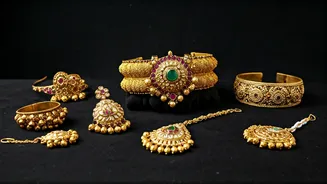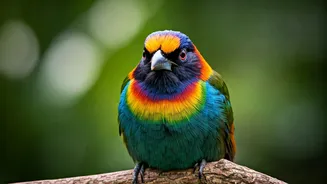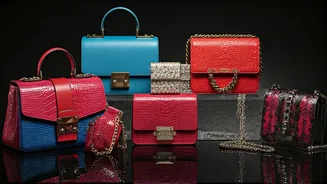Jadau: Royal Glamour
Jadau jewellery, originating from the Mughal era, is celebrated for its elaborate setting of precious gemstones. The 'jadai' technique involves setting gemstones without
any external support, giving them a flawless appearance. Skilled artisans meticulously crafted each piece, resulting in intricate designs. These designs often featured floral motifs, animal figures, and geometric patterns, reflecting the artistic sensibilities of the time. Jadau jewellery was a symbol of royalty, often worn by emperors and their families, signifying wealth and power. The process involves placing the gemstones between layers of gold or other precious metals, highlighting their brilliance. Today, Jadau continues to be a favorite among those who appreciate the blend of history, artistry, and luxury.
Polki: Uncut Diamonds
Polki jewellery features uncut diamonds, which are set in their natural, raw form. This technique has been prevalent in Indian jewellery for centuries. Unlike cut and polished diamonds, Polki diamonds retain their original shape and sparkle, offering a unique aesthetic. The setting style of Polki often involves encasing the diamonds within a metal frame, usually gold. The use of uncut diamonds creates a distinct, vintage look, often paired with enamel work (meenakari) on the reverse side. Polki jewellery is versatile, from elaborate necklaces to delicate earrings, each piece reflects the beauty of the raw diamond. Its appeal lies in its simplicity and the authentic appearance of the stones. Polki continues to be a popular choice for special occasions and weddings.
Kundan: Gold Setting
Kundan jewellery is characterized by setting gemstones in a frame of gold, creating an incredible look of jewels. The technique involves placing gemstones in a pure gold foil, which is then pressed to tightly secure the stones. This method gives the stones a high degree of brilliance. The setting of Kundan is traditionally known as 'Pachchikam', where the gemstones and gold are linked together. This jewellery often features intricate designs and vivid colours, often complemented by Meenakari work on the back. Kundan pieces are not just jewellery; they are works of art, appreciated for their craftsmanship and the beauty they bring. Kundan continues to be a staple in Indian bridal and festive jewellery.
Meenakari: Enamel Art
Meenakari is the art of enameling metal surfaces, typically gold, with vibrant colours. This technique originated in Persia and was embraced by Indian artisans. The process involves applying enamel paints to the metal, then firing the piece at high temperatures to set the enamel. The results are intricate, colourful patterns and designs. Meenakari is often used on the reverse side of Kundan and Polki jewellery, creating double-sided beauty. The themes in meenakari vary, from floral motifs to depictions of gods, goddesses, and scenes from mythology. The art of Meenakari is often seen in bangles, earrings, and pendants, that enhance the beauty of the design. Each piece is a testament to the skill and artistry of the craftsman.
Temple Jewellery: Divine Inspiration
Temple jewellery, drawing inspiration from temple architecture and deities, features motifs of gods, goddesses, and temple structures. It's often made of gold and intricately designed to reflect devotion and spirituality. The pieces typically include depictions of gods like Ganesha, Lakshmi, and other religious symbols. Temple jewellery is commonly seen in necklaces, bangles, and earrings, often worn during religious ceremonies or traditional events. The designs reflect the artistry and cultural heritage of South India, showcasing a blend of elegance and tradition. Temple jewellery is worn by women for auspicious occasions, representing faith and prosperity.
Navratna: Nine Gems
Navratna jewellery incorporates nine gemstones that represent the nine planets in Vedic astrology. These stones include diamond, pearl, red coral, emerald, yellow sapphire, diamond, blue sapphire, hessonite, and cat’s eye. The arrangement of the gems is very important, typically set in a specific order to maximize their astrological benefits. The design of Navratna jewellery can vary, from pendants to rings and necklaces, where the stones are arranged in a specific pattern. It's believed that wearing Navratna jewellery brings prosperity, health, and good fortune, balancing the wearer's life. This type of jewellery has cultural significance, and each stone is associated with specific astrological advantages. Navratna jewellery holds a special place in Indian culture for its beliefs and artistry.
Filigree: Fine Metalwork
Filigree is a delicate form of metalwork using fine gold or silver wires, twisted, and shaped to create intricate designs. The wires are soldered together to form detailed patterns, often resembling lace. The patterns include floral motifs, geometric designs, and other decorative elements. Filigree jewellery has been around for centuries, with different regions of India showcasing unique styles. It's characterized by its lightweight feel and airy appearance, making it suitable for earrings, pendants, and other adornments. Filigree jewellery is prized for its craftsmanship and the exquisite details, which reflect the dedication of the artisans involved. The pieces are beautiful, reflecting the culture and the artistry of the specific region.













